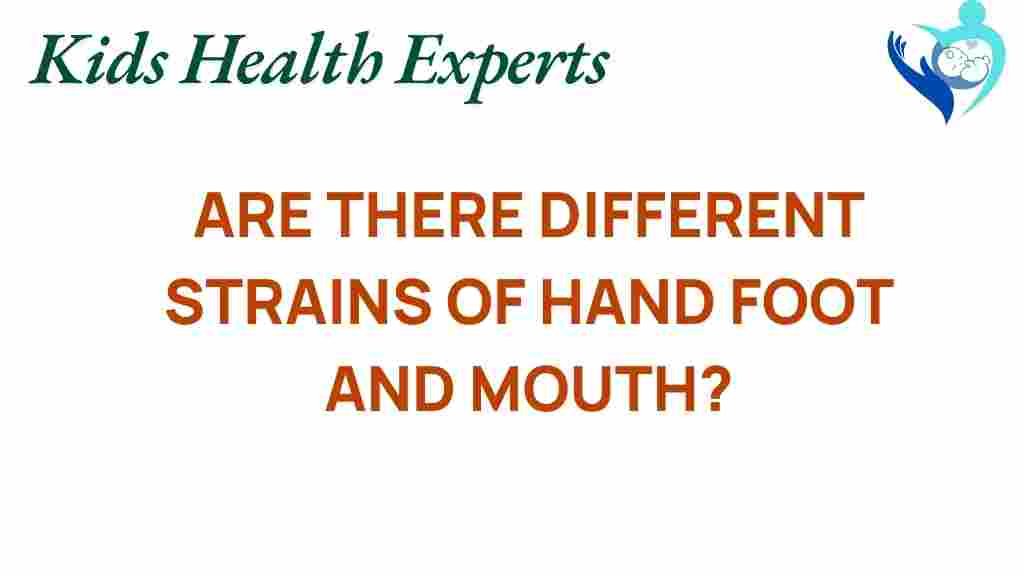Unraveling the Mystery: Are There Different Strains of Hand, Foot, and Mouth Disease?
Hand, foot, and mouth disease (HFMD) is a common viral infection that primarily affects children under the age of five. It is characterized by fever, sores in the mouth, and a rash on the hands and feet. Despite its name, HFMD is not limited to just these areas; it can also affect other parts of the body. Understanding the different strains of this viral infection is crucial for effective prevention and treatment. In this article, we will explore the strains of hand, foot, and mouth disease, their symptoms, prevention strategies, treatment options, and the impact of outbreaks on public health.
Understanding Hand, Foot, and Mouth Disease
HFMD is caused by a group of viruses, most commonly the coxsackievirus A16 and enterovirus 71. These viruses are highly contagious and can spread through direct contact with an infected person’s saliva, blister fluid, or feces. The infection typically occurs in outbreaks, especially in childcare settings, due to close contact among children.
Different Strains of Hand, Foot, and Mouth Disease
While the term “hand, foot, and mouth disease” refers to a specific set of symptoms, it encompasses various strains of viruses. The most notable strains include:
- Coxsackievirus A16: This is the most common cause of HFMD and is often associated with mild symptoms.
- Enterovirus 71: This strain can lead to more severe symptoms and complications, including neurological issues.
- Coxsackievirus A6: This strain is increasingly recognized and can cause a more aggressive form of HFMD, with rashes that may be more widespread.
Understanding these strains is vital for healthcare professionals and parents alike, as it can influence the severity of the disease and the necessary response.
Symptoms of Hand, Foot, and Mouth Disease
The symptoms of HFMD typically appear 3 to 7 days after exposure to the virus. Common symptoms include:
- Fever: A mild to moderate fever is often one of the first signs.
- Sore throat: Children may complain of pain in the throat.
- Oral sores: Painful red spots can develop in the mouth, often turning into ulcers.
- Rash: A rash may appear on the hands, feet, and sometimes on the buttocks or legs, which can develop into blisters.
In most cases, HFMD is a mild illness that resolves on its own within a week to ten days. However, some strains, particularly enterovirus 71, can lead to serious complications, emphasizing the importance of monitoring symptoms closely.
Prevention of Hand, Foot, and Mouth Disease
Preventing the spread of hand, foot, and mouth disease is crucial, especially in settings where children congregate. Here are some effective prevention strategies:
- Hand Hygiene: Encourage frequent handwashing with soap and water, especially after using the bathroom and before eating.
- Avoid Close Contact: Keep infected children away from others until they are no longer contagious, which is usually after the sores have healed.
- Disinfect Surfaces: Regularly clean and disinfect frequently-touched surfaces and objects.
- Teach Respiratory Etiquette: Encourage children to cover their mouth and nose with a tissue or elbow when coughing or sneezing.
By implementing these measures, parents and caregivers can help reduce the risk of HFMD outbreaks in their communities.
Treatment Options for Hand, Foot, and Mouth Disease
There is no specific antiviral treatment for hand, foot, and mouth disease. Management typically focuses on relieving symptoms. Here are some common treatment options:
- Pain Relief: Over-the-counter pain relievers, such as acetaminophen or ibuprofen, can help alleviate fever and discomfort.
- Hydration: Ensuring that the child stays hydrated is crucial, especially if they have difficulty swallowing due to mouth sores.
- Soft Foods: Offer soft, bland foods that are less likely to irritate mouth sores, such as yogurt, applesauce, and smoothies.
- Topical Treatments: Some topical medications may help soothe mouth pain, but always consult a healthcare professional before use.
If symptoms worsen or if there are signs of complications, such as difficulty breathing or high fever, seek medical attention immediately.
Outbreaks of Hand, Foot, and Mouth Disease
Outbreaks of HFMD often occur in daycare centers, preschools, and elementary schools. Understanding the dynamics of these outbreaks can aid in public health efforts:
- Seasonality: HFMD outbreaks are most common in summer and fall.
- Rapid Spread: The disease spreads quickly among children due to close contact, making surveillance and rapid response crucial.
- Public Health Response: Health departments may issue guidelines for managing outbreaks, including temporary closures of affected facilities.
For more information on public health measures and management of outbreaks, consult the CDC’s resource page.
Troubleshooting Tips for Parents
As a parent, dealing with HFMD can be challenging. Here are some troubleshooting tips for managing the situation:
- Monitor Symptoms: Keep a close eye on your child’s symptoms and take notes on any changes.
- Communicate with Caregivers: Inform teachers and caregivers if your child has been diagnosed to help prevent further spread.
- Consult a Doctor: If you’re unsure about the severity of symptoms or potential complications, don’t hesitate to seek medical advice.
- Keep Calm: Remember that HFMD is usually a mild illness, and most children recover fully without complications.
Conclusion
Hand, foot, and mouth disease is a common viral infection that primarily affects children, with different strains leading to varying symptoms and severity. Understanding these strains, recognizing the symptoms, and knowing how to prevent and treat HFMD can help parents and caregivers manage this illness effectively. By promoting good hygiene practices and being vigilant during outbreaks, we can protect our children and communities from the spread of hand, foot, and mouth disease.
For further reading on this topic, you can visit this link for in-depth insights and updates.
This article is in the category Conditions and created by KidsHealthExperts Team

1 thought on “Unraveling the Mystery: Are There Different Strains of Hand, Foot, and Mouth Disease?”